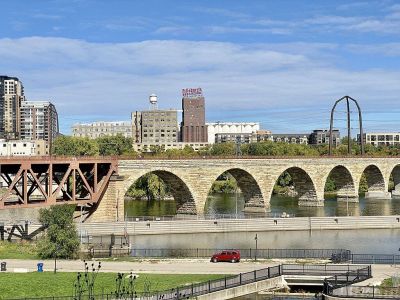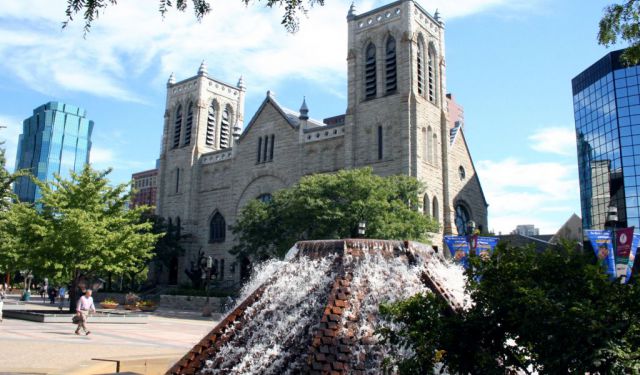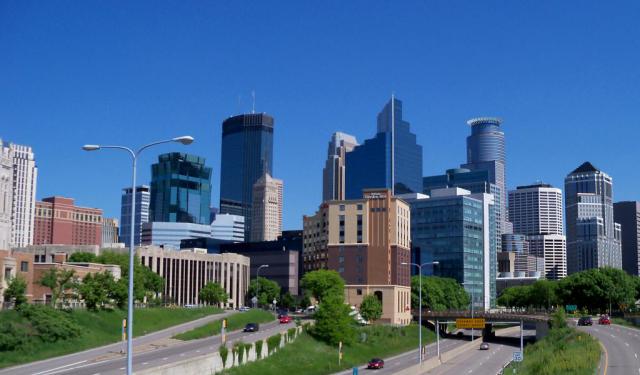
Stone Arch Bridge, Minneapolis (must see)
The Stone Arch Bridge in Minneapolis is a striking symbol of the city’s industrial glory days. Stretching across the Mississippi River at Saint Anthony Falls, it serves as a gateway to some of the city’s most picturesque views. Not only is it the only stone-arched bridge along the entire Mississippi River, but it also claims the title of the second-oldest bridge on the waterway—only losing to Saint Louis’s Eads Bridge in a historical game of “who’s older”.
Built in 1883 by railroad tycoon James J. Hill to shuttle passenger trains to a station a mile west, the bridge was initially nicknamed “Hill’s Folly”. Yet once its value in connecting passengers became clear, those skeptics had to eat their words (and maybe some humble pie). Engineer Charles C. Smith designed its graceful arches to flow with the nearby falls and surrounding terrain, using local granite from Sauk Rapids and magnesium limestone from Mankato and Iowa for the upper sections.
In its long lifetime, the Stone Arch Bridge has worn many hats. It got a wider girth in 1925 to support larger railcars, only to trade the rail life for a pedestrian and cyclist paradise in 1994. By 1971, it made the National Register of Historic Places, and in 1974, it nabbed a National Historic Civil Engineering Landmark title. Fast forward to 2005, and the bridge received a glow-up with indirect lighting.
Today, the bridge moonlights as a festival hotspot, hosting Independence Day fireworks and Minneapolis Aquatennial displays that draw oohs and ahhs from the crowds. It’s also a year-round runway for skyline selfies, views of the historic Pillsbury “A” Mill, the Mill City Museum, and more. And with the lively Main Street restaurants and the Guthrie Theater just steps away, the Stone Arch Bridge is less a relic of the past and more a vibrant link between history and modern city life.
Built in 1883 by railroad tycoon James J. Hill to shuttle passenger trains to a station a mile west, the bridge was initially nicknamed “Hill’s Folly”. Yet once its value in connecting passengers became clear, those skeptics had to eat their words (and maybe some humble pie). Engineer Charles C. Smith designed its graceful arches to flow with the nearby falls and surrounding terrain, using local granite from Sauk Rapids and magnesium limestone from Mankato and Iowa for the upper sections.
In its long lifetime, the Stone Arch Bridge has worn many hats. It got a wider girth in 1925 to support larger railcars, only to trade the rail life for a pedestrian and cyclist paradise in 1994. By 1971, it made the National Register of Historic Places, and in 1974, it nabbed a National Historic Civil Engineering Landmark title. Fast forward to 2005, and the bridge received a glow-up with indirect lighting.
Today, the bridge moonlights as a festival hotspot, hosting Independence Day fireworks and Minneapolis Aquatennial displays that draw oohs and ahhs from the crowds. It’s also a year-round runway for skyline selfies, views of the historic Pillsbury “A” Mill, the Mill City Museum, and more. And with the lively Main Street restaurants and the Guthrie Theater just steps away, the Stone Arch Bridge is less a relic of the past and more a vibrant link between history and modern city life.
Want to visit this sight? Check out these Self-Guided Walking Tours in Minneapolis. Alternatively, you can download the mobile app "GPSmyCity: Walks in 1K+ Cities" from Apple App Store or Google Play Store. The app turns your mobile device to a personal tour guide and it works offline, so no data plan is needed when traveling abroad.
Stone Arch Bridge on Map
Sight Name: Stone Arch Bridge
Sight Location: Minneapolis, USA (See walking tours in Minneapolis)
Sight Type: Attraction/Landmark
Guide(s) Containing This Sight:
Sight Location: Minneapolis, USA (See walking tours in Minneapolis)
Sight Type: Attraction/Landmark
Guide(s) Containing This Sight:
Walking Tours in Minneapolis, Minnesota
Create Your Own Walk in Minneapolis
Creating your own self-guided walk in Minneapolis is easy and fun. Choose the city attractions that you want to see and a walk route map will be created just for you. You can even set your hotel as the start point of the walk.
Saint Paul Introduction Walking Tour
Saint Paul is a fantastic example of a city that has grown through a diverse range of cultures. The location near the Mississippi River helped make what would later become the city a significant center of local trade. The Dakota Sioux tribe were among the earliest residents, and European settlement that included French-Canadian fur traders and Catholic missionaries occurred during the 1830s to... view more
Tour Duration: 2 Hour(s)
Travel Distance: 3.4 Km or 2.1 Miles
Tour Duration: 2 Hour(s)
Travel Distance: 3.4 Km or 2.1 Miles
Historical Churches
The "City of Lakes”, Minneapolis, doesn't pride itself solely on the lakes. In fact, you will be amazed by how many churches, cathedrals, and other places of worship are found throughout the city. These sacred structures have played a significant role in the development of Minneapolis and continue to serve as pillars of faith and community. Let's take a look at some of the most... view more
Tour Duration: 1 Hour(s)
Travel Distance: 2.8 Km or 1.7 Miles
Tour Duration: 1 Hour(s)
Travel Distance: 2.8 Km or 1.7 Miles
University of Minnesota - Minneapolis Campus Walking Tour
Founded in 1851, seven years before Minnesota became a state, the University of Minnesota is one of the largest educational institutions in the United States. The university campus in the “Twin Cities” of Minneapolis and Saint Paul, spread along the bank of the Mississippi River, is a sprawling hub renowned for its rich academic environment and vibrant life.
One of the central gathering... view more
Tour Duration: 2 Hour(s)
Travel Distance: 2.9 Km or 1.8 Miles
One of the central gathering... view more
Tour Duration: 2 Hour(s)
Travel Distance: 2.9 Km or 1.8 Miles
Minneapolis Introduction Walking Tour
Minneapolis is a major city in Minnesota, straddling the Mississippi River. Together with neighboring Saint Paul, the state capital of Minnesota, it forms the metropolitan area collectively known as the "Twin Cities."
Before European settlement, the site of Minneapolis was inhabited by Dakota people. The settlement was founded along Saint Anthony Falls — the only natural waterfall... view more
Tour Duration: 2 Hour(s)
Travel Distance: 4.2 Km or 2.6 Miles
Before European settlement, the site of Minneapolis was inhabited by Dakota people. The settlement was founded along Saint Anthony Falls — the only natural waterfall... view more
Tour Duration: 2 Hour(s)
Travel Distance: 4.2 Km or 2.6 Miles




